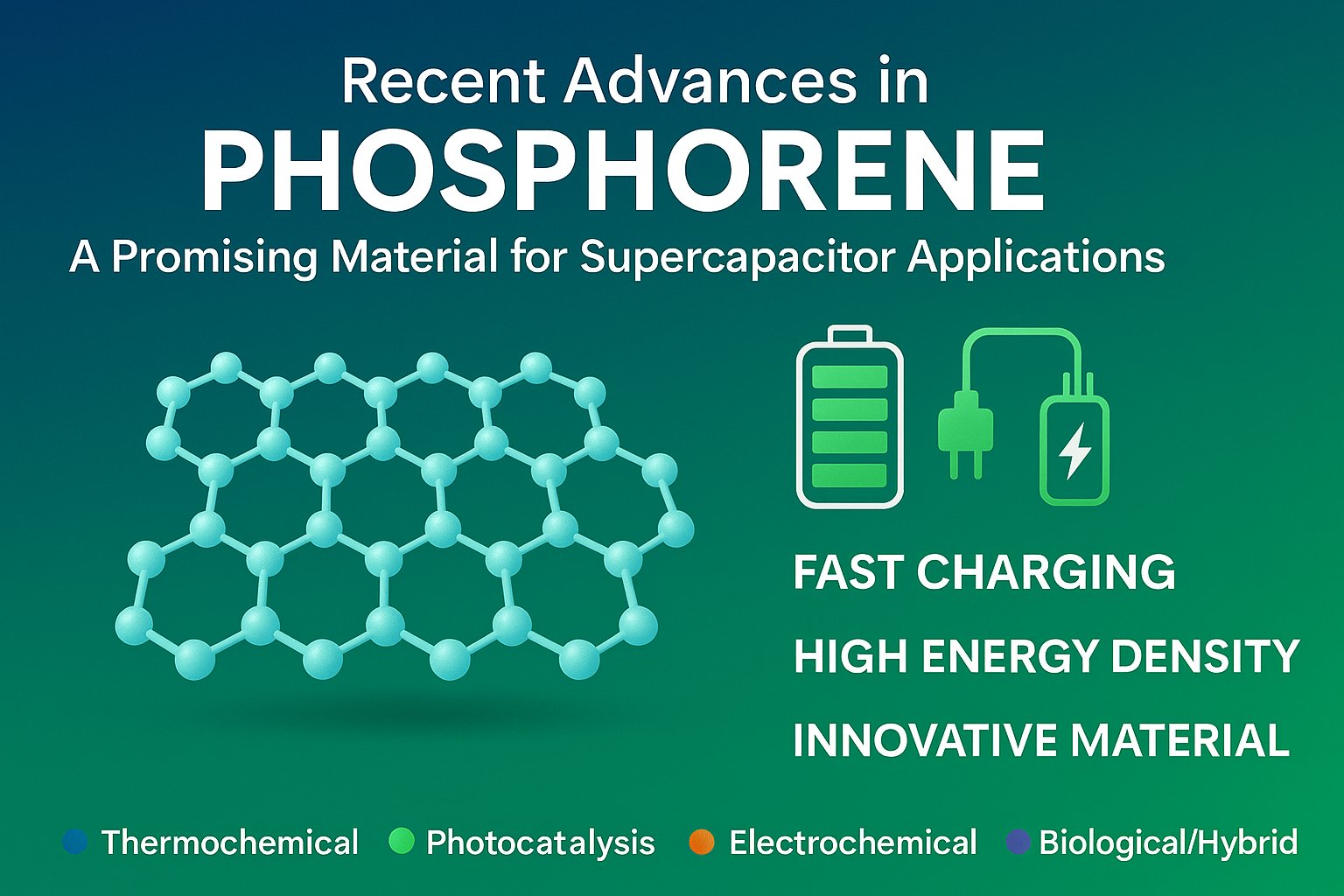Imagine charging your phone in seconds or powering electric vehicles with batteries that last longer than ever before. Thanks to phosphorene, a groundbreaking material, these futuristic ideas may soon become reality. A recent study highlights the massive potential of this super-thin, high-performance material in building better energy storage devices. Could phosphorene be the key to solving the energy challenges of tomorrow?
- ⚡ Supercapacitor Importance: Supercapacitors offer high-power density and rapid charge-discharge capabilities, enabling quick energy bursts for EVs, industrial machinery, UPS systems, and renewable energy stabilization.
- 🧪 Material Innovation: Research focuses on advanced materials (hierarchical porous carbons, graphene, conductive polymers, phosphorene) with high surface area, conductivity, and capacitance for enhanced supercapacitor performance.
- 🟦 Phosphorene Overview: A 2D black phosphorus variant with puckered structure, tunable bandgap, high theoretical capacitance, and excellent conductivity, making it promising for next-generation energy storage.
- 🔬 Electronic & Structural Properties: Phosphorene exhibits semiconducting behavior, anisotropic ion diffusion, and high carrier mobility (285–1000 cm²/Vs), with layer-dependent tunable bandgaps (0.3–2.0 eV) suitable for FETs and photovoltaics.
- 🏗️ Mechanical Properties: Anisotropic Young’s modulus and high tensile strain tolerance (zigzag 27%, armchair 30%) make phosphorene flexible, ductile, and ideal for nanoelectromechanical systems and supercapacitor electrodes.
- 🌐 Surface & Porosity: High surface-to-volume ratio, controlled pore distribution, and increased hydrophobicity enhance ion diffusion, electrical conductivity, and overall electrode performance in supercapacitors.
- ⚠️ Stability Challenges: Phosphorene degrades rapidly in air due to oxidation and moisture, especially for thin layers, limiting long-term electrochemical stability and commercial viability.
- 🏁 Development Timeline: Since 2014, phosphorene has progressed from isolation to industrial-scale applications in flexible electronics, sensing, energy storage, and quantum devices through advanced synthesis, functionalization, and theoretical modeling.
- 🔄 Comparison with 2D Materials: Unlike graphene (zero bandgap) or TMDCs, phosphorene has a tunable bandgap, anisotropic electrical/thermal/mechanical properties, and high flexibility, offering advantages for semiconductors, optoelectronics, and supercapacitors, though environmental stability is a concern.
- 🛠️ Stabilization Needs: Effective encapsulation or chemical modification strategies are required to mitigate degradation under ambient conditions to fully exploit phosphorene’s potential in supercapacitor applications.
- 📊 Summary Tables: Tables compare phosphorus allotropes and 2D materials’ structural, electronic, mechanical, thermal, and optical properties, emphasizing phosphorene’s distinct advantages and limitations.
The Research at a Glance
The research paper titled “Recent Advances in Phosphorene: A Promising Material for Supercapacitor Applications”, authored by Niraj Kumar, Radhamanohar Aepuru, Seul-Yi Lee, and Soo-Jin Park, spotlights phosphorene as the next big thing in energy storage. Conducted across several leading institutions, the team explored the unique properties of phosphorene—an atom-thin layer derived from black phosphorus—and its potential in supercapacitors. Published in the Materials Science and Engineering: R: Reports journal, the study offers a comprehensive look at how this material can revolutionize future technologies.
Why Phosphorene Matters
Phosphorene is a two-dimensional (2D) form of black phosphorus, just one atom thick. What makes it exceptional is its combination of high electrical conductivity, mechanical strength, and flexibility. Additionally, it has an impressive ability to store electrical charge, making it an ideal candidate for use in supercapacitors—devices used for fast energy storage and release.
Unlike traditional batteries, which can take hours to charge and degrade over time, supercapacitors provide rapid energy bursts and maintain their capacity over many cycles. According to the study, phosphorene’s unique properties could address long-standing challenges in energy storage, such as improving charging speed, capacity, and device stability.
What the Researchers Discovered
The paper discusses several key findings:
- High Carrier Mobility: Phosphorene can rapidly transport electrical charges, allowing supercapacitors to charge and discharge faster.
- Outstanding Electrochemical Properties: Its structure and composition enable it to store large amounts of energy in a stable and efficient way.
- Versus Other Materials: Compared to existing 2D materials like graphene, phosphorene has better performance when it comes to energy density and flexibility, making it more favorable for commercial-scale applications.
- Sustainability and Longevity: Phosphorene retains its properties over repeated charging cycles, making it a long-lasting solution for energy storage.
The study also highlights novel strategies to stabilize phosphorene, which tends to degrade quickly when exposed to air. From surface coatings to encapsulation techniques, researchers are working on ways to improve its durability, bringing it closer to being ready for commercial use.
Why It Matters
Energy storage is one of the most critical challenges of our time. With the rise of renewable energy, electric vehicles, and portable technology, we need efficient, sustainable, and high-performance ways to store electricity. Phosphorene supercapacitors could lead to faster-charging smartphones, improved solar energy storage, and even lighter, more efficient batteries for electric cars.
Supercapacitors made from phosphorene can also be adapted for challenging environments like space exploration, where durability and efficiency are vital. As the demand for energy storage technology skyrockets, phosphorene offers a promising solution to meet global energy needs sustainably.
What’s Next?
Although the prospects for phosphorene are exciting, challenges remain. Researchers must overcome its tendency to degrade when exposed to oxygen and humidity, as well as find cost-effective ways to produce it on an industrial scale. However, with advances in stabilization techniques and scalable manufacturing, phosphorene could soon transition from the lab to everyday applications.
Bottom Line
This new research underscores how phosphorene, a once-overlooked material, may be the key to unlocking faster, more reliable energy storage technology. With its remarkable properties and growing potential, phosphorene might just power the innovations of tomorrow—one atom-thick layer at a time.
Stay tuned for further developments in the world of phosphorene, as researchers across the globe keep turning this supermaterial into a super solution for energy storage and beyond!
Recent advances in phosphorene: A promising material for supercapacitor applications
- Niraj Kumar, Radhamanohar Aepuru, Seul-Yi Lee, Soo-Jin Park
- Phosphorene shows high electrical conductivity.
- Superior energy density for supercapacitors.
- Stabilization techniques enhance practical applications.
- Outperforms graphene in energy storage.
- Promises faster-charging, long-lasting energy solutions.




